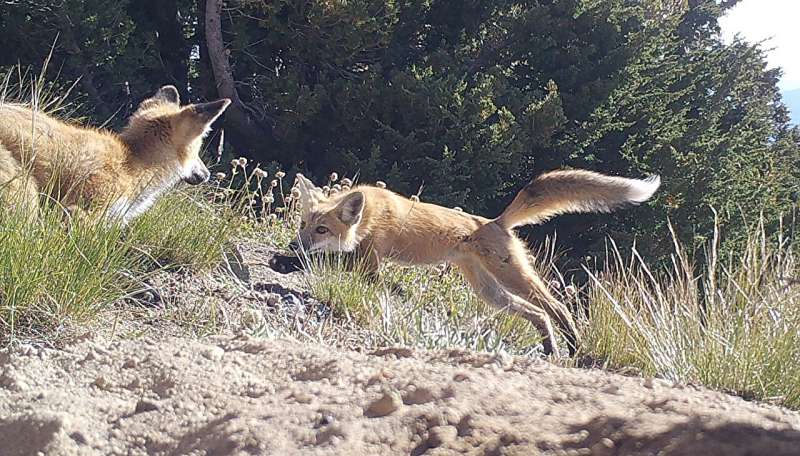
Two Lassen red fox cubs play together. Credit: California Department of Fish and Wildlife
A rescue effort can take many forms – a lifeboat, a fire hose, an airlift. For animals whose populations are declining due to inbreeding, genetics itself can be a lifesaver.
Genomics research led by the University of California, Davis reveals clues about the mountain red fox’s distant past that may be critical to their future survival. This study is published in the journal Molecular biology and evolutionexamines the potential of genetic rescue to help restore populations of these mountain-dwelling red foxes. This research is particularly relevant for the estimated 30 or fewer native red foxes living in California’s Lassen Peak region.
This study found that inbreeding affects the Lassen red fox population. Thousands of years ago—long before illegal trapping and poisoning decimated their populations in the 1890s and early 1900s—red foxes were not only abundant in these mountains, but more closely related to neighboring foxes in Oregon, the Rocky Mountains, and the Cascades. Washington were connected. They are today. This puts them in a good position for genetic rescue, should managers decide to follow through and reconnect populations.
Lead author Keith Quinn, who conducted the research as a UC Davis postdoctoral researcher with the Mammal Ecology and Conservation Unit in the School of Veterinary Medicine, said: “Nothing we found would deprive red foxes of genetic rescue. does not.” He is now a research biologist at the USDA Forest Service’s Rocky Mountain Research Station. This study shows that genetic rescue can be a viable option for the Lassen population.
Relief forces
Genetic rescue is a protective tool to reverse the effects of inbreeding depression, when inbreeding reduces an animal’s fitness and ability to reproduce. Genetic rescue involves bringing new individuals into a population to introduce genetic diversity and stimulate growth.
This tool is not taken lightly, and managers must first understand the severity of inbreeding, the genetic rescue of the historical base, and the deeper evolutionary relationships of foxes to each other.
To fill these knowledge gaps, scientists sequenced 28 complete genomes from four subspecies of the mountain red fox. These include small, isolated populations in the Pacific Mountains, Oregon Cascades, Lassen Cascades, and Sierra Nevada, as well as a larger population in the Rocky Mountains and a subspecies in the Sacramento Valley. Using genomic technology, authors can look back to see if a population was always isolated, to what extent and when it began to change.

A red fox rests near Lassen Peak in this 2022 Comet Camera image. A study at UC Davis found that inbreeding affects Lassen’s red foxes, which were abundant in the area before the 1900s. Credit: California Department of Fish and Wildlife
Abundant, relevant and diverse
This study found high levels of recent inbreeding in the Lassen and Sierra Nevada red fox populations, with the Lassen red fox being a high priority for intervention. According to the study, only one mountain red fox has entered the Lassen population in more than 20 years of monitoring.
The data also showed that 10,000 to 12,000 years ago, mountain red foxes were abundant, connected, and genetically diverse in the western United States. Quinn said the Lassen population was probably connected to Oregon’s red foxes for the past century and diverged relatively recently.
A promising way
Collectively, these findings point to a promising path forward for Lassen’s red foxes and other red foxes facing similar challenges.
“We think trapping reduced their population, but we didn’t know what kept them small,” said lead author Ben Sacks, director of the Mammal Conservation and Ecology Unit at UC Davis School of Veterinary Medicine. “Now we see that what’s keeping them small seems to be inbreeding depression. If what caused their decline is gone, can we bring them back? There’s hope here.”
Kevin agrees, “Not long ago, this was an abundant, connected and diverse population. That diversity is still there. If we were to recover them as a group, these foxes may still have a lot of adaptive potential.”
However, he cautions that true genetic “rescue” requires rewiring the entire subspecies—not just growing a single population.
“If we just look at each little pocket individually, they’re going to struggle, but if we look at the entire mountain system, restoration is still possible,” Quinn said.
Other authors include Sophie Perkler-Quisquater of UC Davis and Michael Buchalski of the California Department of Fish and Wildlife.
More information:
Keith B. Quinn et al., Complete Genomes A Genetic Rescue Strategy for Mountain Red Foxes in North America, Molecular biology and evolution (2024). DOI: 10.1093/molbev/msae193
quote: Genetic rescue for rare red foxes? Research uncovers options to recover red fox population Lassen (2024, September 26) Retrieved September 29, 2024, from https://phys.org/news/2024-09-genetic-rare-red-foxes-uncovers.html is
This document is subject to copyright. Except for any fair dealing for the purpose of private study or research, no part may be reproduced without written permission. Content is provided for informational purposes only.
#Genetic #rescue #rare #red #fox #Research #explores #options #restoring #Lassen #red #fox #population